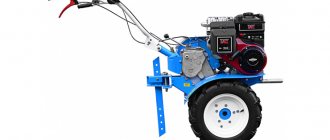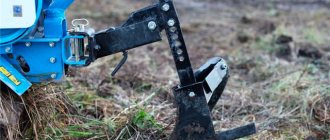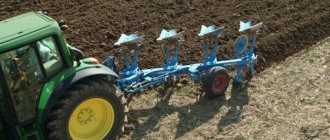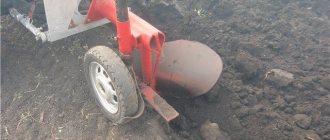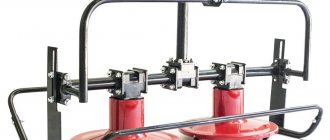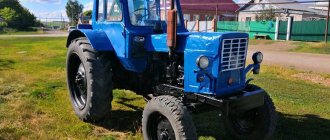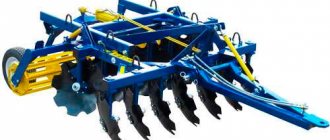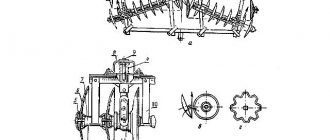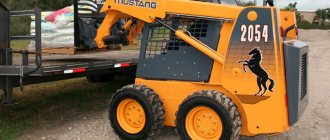Mounted plow PLN-3-35
Every year, various devices appear that greatly facilitate the performance of heavy work in agriculture. And it is especially worth highlighting among similar equipment the PLN-3-35 plow, which today is one of the most popular mounted plows, with an affordable price and trouble-free repair.
This model, new or used, due to its technical characteristics, is used for arable work on various types of soils: light, smooth, as well as medium-heavy, in which all types of grain are planted. The ground must first be cleared of weeds and stones. There are a lot of videos on this topic on the Internet.
Design of plow bodies
LN-3-35 hulls can be screw, cultural and semi-screw. Cultivated ones are the weakest and are suitable only for cultivating old arable soils. Screws are able to plow land heavily overgrown with weeds and virgin soil.
Plow frame PLN-3-35 Modification with harrow
The half-screw body is a medium-power unit that allows you to plow fallow soils. An elongated feather is mounted to it, with the help of which the power of the semi-screw body becomes higher than that of the cultural one.
The body design directly depends on the type of soil that is supposed to be cultivated. If, for example, it is necessary to plow heavy soil with crushing for planting root crops, you will have to resort to the use of a combined body. In it, the blade and ploughshare are shortened, but there is a rotor that is driven by the PTO of the traction unit and which crushes heavy soil with its blades.
Moldless plows
The category of moldless plows includes subsoilers-flat-cutters and chisel rippers. Plowing with such devices is characterized by deep loosening of the fertile layer with minimal disruption of its upper part. This treatment helps protect the soil from wind erosion and drying out.
Mounted flat cutter KPG-2-150
The working parts of the flat cutter are made in the form of powerful pointed paws, ensuring loosening over the entire thickness of the horizon without disturbing the surface. Chisel plows are equipped with chisel-shaped rippers, which allow, together with effective loosening, at maximum depth, to destroy the compacted layer of the arable sole, ensuring the deepening of the arable layer and the supply of moisture from the lower layers.
Mounted chisel PCHN-4
The majority of models of moldless rippers require the creation of a significant traction force from the tractor for the unit to operate. Among the non-mouldboard devices on the market, the lowest traction force, as part of such an arable unit, requires a tractor of at least 2nd traction class and higher.
Trailed chisel wide-cut subsoiler
It should also be noted that there are models of plows with universal use, where, when converting working bodies, the ripper device can be used as a moldboard plow and a moldboardless ripper. An example of such a land-cultivating mounted machine is the high-speed combined universal plow - PSKu-5(6), which in the moldboard mode is equipped with screw blades, and in the non-mouldboard mode the blades are dismantled.
Mounted PSKu-5
Brands of flat cutters
Decoding the brands of flat cutters
KPG-2-150 cultivator flat-cutter deep-ripper with 2 working parts, with the grip of one lancet share 150 cm PGN-5 mounted flat-cutter-subsoiler with 5 cutting paws PGP-7 trailed flat-cutter-subsoiler with 7 cutting tines
Moldboard-less flat cutter ripper PGN 5
| Brands of flat cutters | Working width, m/productivity, ha per hour | Required traction force of the tractor, t.p. |
| KPG-250 | 2,5/1,08-1,35 | 3-4 |
| KPG-2-150 | 3.2/ up to 3 | 3-4 |
| PGN-3 | 3,2/3 | 3-4 |
| PGN-5 | 5,3/5,3 | 5-6 |
| PGN-7 | 7,4/7,4 | 5-6 |
| GGP-7 | 7,4/7,4 | 5-6 |
Chisel brands
Examples of deciphering the abbreviation of subsoiler chisels:
PCHN-4.5 mounted chisel plow with a working width of 4.5 m PCHG-3 chisel deep-ripper plow with a working reach of 3 m GCh-4 chisel deep-ripper with a working reach of 4 m PCH-3/1-6 – chisel plow with a working reach of 3 m, one row of working tools with 6 rippers PCH-4.5/2-9 – chisel plow with a grip of 4.5 m, two rows of working tools with 9 rippers
| Brands of chisel subsoilers | Working width, m/productivity, ha per hour | Required traction force of the tractor, t.p. |
| GRZ-1.5 | 1,5/0,8-1,2 | 2 |
| PCH-2/1-4 | 2/1,5 | 2-3 |
| PCH-2,3 | 2,3/1,5 | 2-3 |
| PCHN-2.5 | 2,5/1,8 | 2-3 |
| PCh-2.5/2-5 | 2,5/1,8 | 3-4 |
| PCHG-3 | 3/1,5-3 | 3 |
| PCH-3/1-6 | 3/1,5-3 | 3-4 |
| PCH-3.5 | 3,5/2,5 | 4-5 |
| PCh-3.5/2-7 | 3,5/2,5 | 4-5 |
| PCH-4/2-8 | 4/3-4 | 5 |
| PCHG-4.2 | 4,2/2-4,2 | 5 |
| PCH-4.5 | 4,5/3,5 | 5-6 |
| PCH-4.5/2-9 | 4,5/3,5 | 5-6 |
| GC-4 | 4/3,2-4,8 | 5-6 |
| PCHG-5.4 | 5,4/2,5-5,4 | 5-6 |
Specifications
PLN-3-35, new or used, is quite easy to adjust and operate, thanks to which one person can handle it.
| Working width | 1.05 m |
| Plowing speed | 5-12 km/h |
| Performance | 0.5 – 0.7 ha/h |
| Processing depth | 20-30 cm |
| Number of cases | 3 pcs. |
| Unit weight | 470 kg |
| Dimensions | 2660x1380x1300 mm |
Aggregation of plows
According to the nature of the connection with the tractor, plows differ in:
- mounted
- semi-trailer
- semi-mounted
- trailed
Mounted - attached rigidly to the three-point hitch of the aggregated machine, the entire mass of which in the transport position falls on the tractor chassis. The implement is transferred to the working and transport position by a hydraulic cylinder of the linkage as part of the hydraulic linkage system of the tractor. All mounted plowing implements have a small working width with no more than 8 ripper bodies in their design.
Semi-trailed and semi-trailed plows are connected through the tractor hitch hitch. To move the unit in the transport position, the plows are equipped with running wheels. Part of the plow's mass is distributed to the tractor's coupling device, and the other part is distributed to the running support wheels as part of the equipment.
Trailed plows are equipped with a chassis that carries the full weight onto its support wheels without exerting force on the tractor coupling.
Semi-mounted arable unit
Semi-trailer arable unit
Trailed arable unit
The translation of trailed and semi-trailer (semi-mounted) devices into the working position is carried out by hydraulic cylinders built directly into the design of the land-cultivating equipment. Such plows are characterized by high productivity and have from 6 to 12 working bodies. Considering the significant traction force required for the operation of such devices, arable units are formed with powerful energy-rich tractors of at least the 5th traction class.
Device
The mounted unit consists of the following elements shown in the drawing:
- hitch;
- coulter;
- support wheels;
- frame;
- hitch for harrows;
- frame.
The support wheels are equipped with a special screw, with which the plowing depth can be adjusted. There are many videos that describe in detail the structure of the plow and its coupling to the tractor. Depending on the calculated depth of processing, a skimmer can be installed, which has several positions;
- for plowing depth 200 mm;
- plowing depth 220 mm;
- processing depth 250 mm;
- cultivation depth 270 mm
- plowing to a depth of 300 mm.
The plow stand in LN-3-35 is made one-piece and the main shares, blade and field board are installed on it. The skimmer has a blade ploughshare with a small surface area and the function of removing plant residues. The wheels are used to adjust the tillage depth. There is also a device through which the tractor is connected to the LN-3-35.
Preparing and setting up the plow for work
The plow is assembled on a special supporting wooden block or beam with a cross-section of 65 or 70 cm. The plow is heavy and if the structure falls, it can kill the tractor driver.
Assembly work is carried out in the following stages:
- Open the packaging and select spare parts; they should be put aside. We lay out the main components in a convenient order.
- We bring the frame into locking mode and install it on the prepared stand.
- The housing is hung and inserted into the stiffening beam and the rack with a bolt. The housing stand is mounted to the frame using locknuts.
- On the left, the skimmers are screwed to the body in front of the body holders using brackets. There is no need to tighten the staples at this stage.
- We secure the support wheels using brackets and spring washers. They are attached to the outside of the structure.
- The support wheels are lowered all the way; to do this, turn the screw nut at the end counterclockwise).
- We tighten all the brackets until they stop and remove the plow from the stand.
- The scraper is mounted to the wheel bracket using washers and nuts.
- The hitch is mounted on the plow frame using bolts, which must be tightened until they stop.
- We screw red reflectors to the back of the main beam.
Photo No. 1 Photo No. 2 Photo No. 3 Photo No. 4 Photo No. 5
The plow is assembled and ready for adjustment. The tincture is carried out in the following steps:
- Before using for the first time, inspect the equipment. Lubricate the wheel bearings and all rubbing parts with grease.
- Set the skimmer to the required plowing depth. The gap between the coulter shares and the body must be at least 250 mm. Using the protrusion on the holder, we adjust the depth of tillage.
- Tighten the skimmer clamps completely. In this case, the field edge of the skimmer covers the edge of the body.
- The PLN plow has a soil grip of 105 cm, so the track should be 1560 mm. To prevent shortfalls when plowing, the right wheel of the machine is placed in the furrow.
- The slanting rods of the mounted part are adjusted after the plow is installed on the ground.
- The braces are placed in the front holes of the rod.
- Before work, it is necessary to adjust the limit chain. The longitudinal rods should swing freely horizontally by 120-130 mm in different directions. To do this, the chain is built with a slight slack.
- Before plowing, it is necessary to adjust the depth by adjusting the traction of the mounted part and the support wheel. Initially, according to the timing of the front wheel, the average depth value is set and the first row is passed. Next, the flash depth is adjusted for each type of soil individually.
- When working, the right side of the frame should always be slightly higher than the left. As the furrow passes, it will break out and be strictly parallel to the soil.
- After passing the furrow, make sure that the plowing is uniform and completely covers the plant residues. There is an adjustment on the left side of the plow that will help make the plow for the MTZ 80 tractor more stable. If the plow moves to the side, then the canopy is moved back.
- If the frame warps, then you need to lengthen the brace.
- You can adjust the plowing depth of the front part of the body using the right link slants from the mounted unit, the rear part using the top one. In this case, the support wheel is placed at the required plowing depth and the position is fixed using a support bolt in the holder.
Setting up the unit
Before you take the equipment out for direct work, you need to set it up at a special site. It is required to take special stands, as shown in the drawing, corresponding to the depth of the intended processing, minus 2-5 cm, and install them under the tractor left wheels and the support plow wheel. Next, the unit with plowshares needs to be lowered onto the platform. Using a screw, the support wheel is tightened until the plowshares come into contact with the surface of the platform.
After this, it is necessary to level the LN-3-35 using the central link and brace of the tractor hitch. The main thing that needs to be done when setting up the unit is to adjust the position of the equipment parallel to the site. In addition, adjustment must be performed in both longitudinal and transverse planes. The plow braces are attached to the longitudinal rods to the front holes. Fastening the frame with the top link through a special hole must be done only with the help of an automatic coupler. If the fastening is carried out through a recess, this may lead to the unit taking an unstable position when plowing.
Adjustment before use
In order to configure the PLN 3 35 plow on the MTZ, special platforms should be used before starting work. This is done even before the unit goes into the field. In this case, special substrates are used, the dimensions of which are determined by the depth of future plowing. Installation is carried out on the left and right, under the wheels for support. After this, the three-furrow plow itself and the plowshares are lowered onto the platform.
The part is scrolled until full contact with the surface is achieved. The support wheel screw is involved in the process.
At the next stage, the plow itself is leveled. The central link and the tractor hitch become indispensable assistants at this stage. Adjusting the plow relative to the platform is the main operation performed in this case. Longitudinal and transverse planes are used equally.
The front holes near the longitudinal rods are equipped with unit struts. Only a special automatic coupler can be used to connect the frame to the top link. The use of a groove is unacceptable; it can lead to additional problems. After some time, you will have to buy a used plow to replace it.
51.5 centimeters is the distance that must be maintained between the axes of the hinges. For this purpose, a so-called left brace is installed. Its length cannot be changed when the main work is already underway.
Be sure to read: Tractor MTZ 952
It is easy to set the required depth for cultivating the land on the stand. 2/3 of the previously set depth is the optimal parameter value. The body behind is lowered to its full depth, and the part in front goes to half the previous value. If the parameters do not match, then additional adjustment is required. The same actions are suggested by the drawing of the PLN 3 35 plow.
Additional nuances
The following rules will help extend the service life:
- To turn, the unit must be installed in a special position. Otherwise, the original characteristics will not be preserved for a long time.
- Circular plowing is prohibited.
- It is recommended to avoid sharp turns.
- Controlling ground clearance helps avoid accidents.
- Plowing with a power setting requires getting rid of the support wheel. Then the depth adjustment occurs automatically.
Maintenance is carried out based on the requirements specified in the accompanying documentation. Typically, such work is carried out every month, at the beginning or end of use of the unit.
Plow at work
Storage of the device involves the use of several schemes:
- Between shifts with breaks in use of up to 10 days.
- With breaks of 10 days - 2 months, it will be short-lived.
- Long-term – with breaks of two months or more.
Plows can be stored in both indoor and outdoor areas if appropriate equipment is available. In this case, it becomes a mandatory requirement to carry out work related to conservation and sealing, and removal of main parts. Some of them require separate storage in warehouse conditions.
When plows are prepared for storage, it is necessary to assess the general technical condition, not only of the entire set, but also of individual parts. The unit must be inspected once every two months, even if it is not in use. When using sheds and open areas, such actions are carried out every month. An immediate check is required if there have been heavy rains, winds, or snowfalls.
Be sure to read: Tractor T 16
Maintenance is carried out under the strict supervision of the person responsible for storage. Long-term registration or deregistration must be registered in special journals and require written documentation.
Nuances
When plowing with PLN-3-35, due to its technical characteristics and in order to avoid unscheduled repairs, the following rules should be followed:
- the tractor can be turned around to lay the next furrow only with the unit in the transport position, as shown in the video below;
- circular plowing is prohibited;
- It is strictly not recommended to make sharp turns;
- To avoid an accident, it is necessary to control the ground clearance.
- When plowing with a power setting, it is necessary to remove the support wheel in advance. In this case, the required depth is maintained automatically using a power regulator.
Special plows
This category of devices includes plows intended not so much for cultivating the soil, but for performing technological operations related to the formation of relief or soil cleansing, such as:
- uprooting roots and stumps
- hilling crops
- cutting irrigation, planting and fire furrows
Universal mounted forestry plow
In the design of these devices, there is no specific underlying system and nature of the work of the working body and processing. The cutting and loosening organs of special plows have a different appearance, with a shape and design that meets the specifics of the work being performed.
Rooter
PKL-70D forest uprooter-furrow cutter
Rooter
Where can I buy a plow PLN 3 35
It is advisable to purchase LN-3-35 directly from the manufacturer. In this case, its price may be 50-60,000 rubles. You can also purchase a used device at a fairly low price. If you decide to buy a PLN-3-35 plow from agricultural machinery dealers, then its price can reach up to 80,000 rubles. This largely depends on the region and the markup set by the seller.
| Manufacturer | Price, rubles |
| Agro Format (Voronezh) | 56 500 |
| Agro server (Moscow) | 55 450 |
| Altaiselmash (Altai) | 57 000 |
| ProfTechKomplekt (Ufa) | 59 000 |
PLN-3-35, regardless of whether it is new or used equipment, thanks to its technical characteristics, allows for high-quality plowing of almost all types of soil, except rocky ones, to a depth of 30 cm. When cultivating the soil, ridges are not formed, and the furrows are smooth , without the formation of collapses. The unit does not allow idle runs, which allows for high-quality cultivation of the soil, while saving fuel.
How do you like the article?
Types of plows
Among the loosening devices, depending on the nature of soil cultivation, there are the following types of plows:
- Dump
- Dumpless
- Special
The first two categories relate to agricultural devices and are used for basic soil cultivation. The devices differ from each other in the nature of loosening, where the first ones provide plowing with the rotation of the soil layer, and the second (non-moldboard) cultivate the fertile layer without turning it over.
Plow body
Working paw of a bladeless flat cutter
Chisel rippers
The category of special plows includes devices designed for reclamation operations or wandering in the development of areas after logging. The working bodies of such devices correspond to the nature of the tasks performed. The example below shows a universal device that provides, during readjustment: uprooting, cutting fire furrows, hilling.
Working parts of a universal forestry plow
